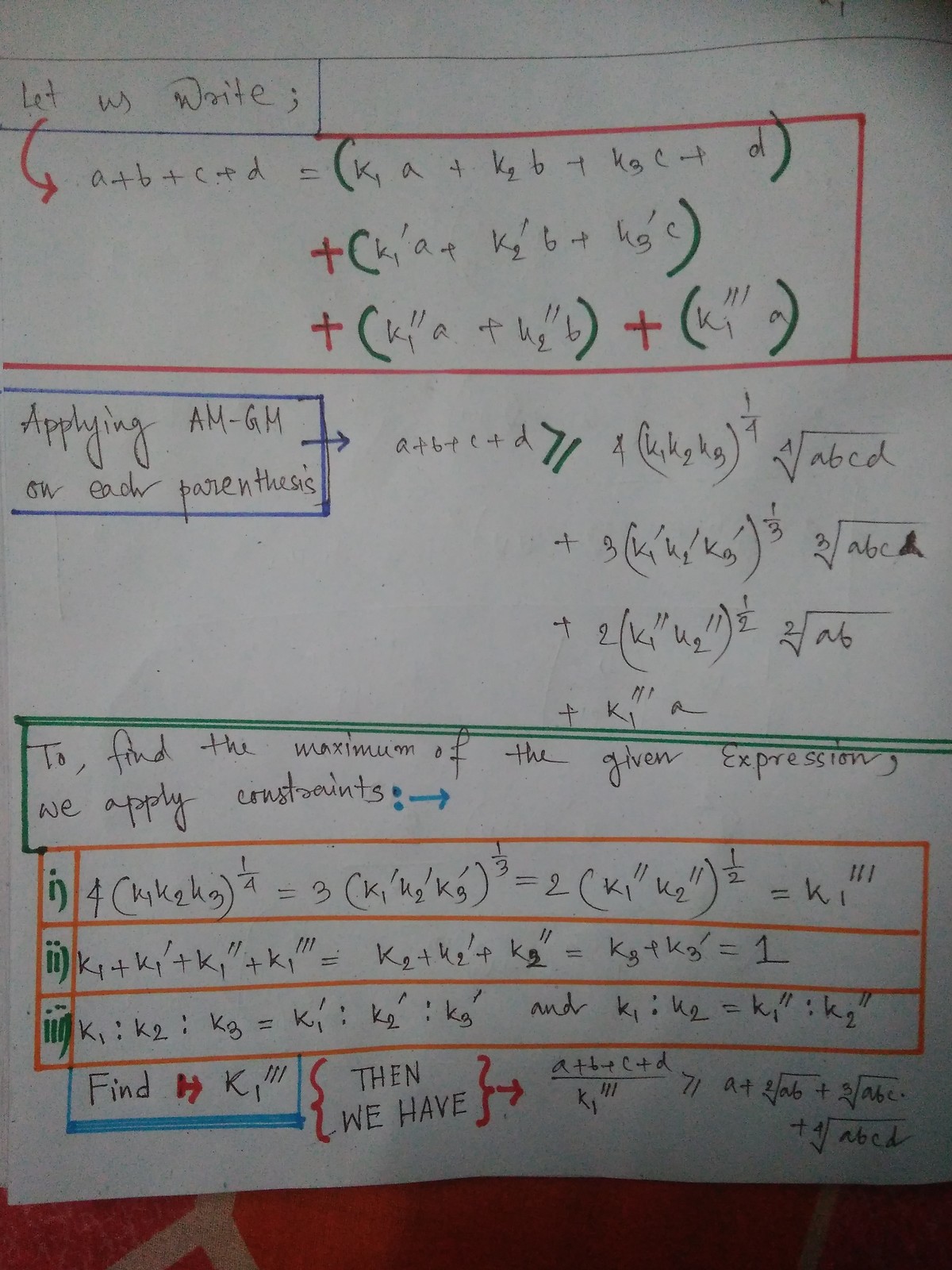Calculus or AM-GM? (part 3)
U = a + a b + 3 a b c + 4 a b c d
Suppose that a , b , c , d > 0 such that a + b + c + d = 1 0 0 . Let the maximum value of U be u . Find the value of ⌊ 1 0 0 0 u ⌋ , where ⌊ ⋅ ⌋ denotes the floor function .
The answer is 142084.
This section requires Javascript.
You are seeing this because something didn't load right. We suggest you, (a) try
refreshing the page, (b) enabling javascript if it is disabled on your browser and,
finally, (c)
loading the
non-javascript version of this page
. We're sorry about the hassle.
2 solutions
 I am trying to give an idea.Though it is not a complete solution I think the rest part can be easily handled.
we first optimize and make suitable constraints , which is necessary and solve the system of equation (note the 9 variable-equation can be easily simplified using the (iii)constraint to a single variable equation and then solve it. The value of k3''' is coming to be 0.703806842.
Then the answer becomes 142084
I am trying to give an idea.Though it is not a complete solution I think the rest part can be easily handled.
we first optimize and make suitable constraints , which is necessary and solve the system of equation (note the 9 variable-equation can be easily simplified using the (iii)constraint to a single variable equation and then solve it. The value of k3''' is coming to be 0.703806842.
Then the answer becomes 142084
I think a sharper bound can be obtained, by some wishful thinking, say the max value is achieved when a = k 2 b = k 4 c = k 6 d , then we have L H S ≤ a + 2 k a + k 2 b + 3 k 2 a + k 2 b + k 4 c + 4 k 3 a + k 2 + k 4 d + k 6 d and we can set the coefficients of each variable on the RHS to be equal, which gives k = 3 2 + 1 3 and this leads to an answer of 163091. Correct me if I'm wrong:).
Very brilliant solution! How did you come up with constraint (iii)?
Log in to reply
To get the maximum value of the desired expression, all three AM/GM inequalities need to be equalities at the same time . Thus we want to be able to have k 1 a = k 2 b = k 3 c = d k 1 ′ a = k 2 ′ b = k 3 ′ c k 1 ′ ′ a = k 2 ′ ′ b and so the desired ratios in (iii) are obtained
Log in to reply
Brilliant! Thanks. This question shows that I did not really understand this AM-Gm inequality.
I don't have a particularly illuminating solution, but here is how I did it.
This is a maximisation subject to a constraint so, we can use Lagrange multiplier and we extremise the following function
U − y ( a + b + c + d − 1 0 0 )
Differentiate w.r.t. a ,b ,c and d gives the following equations to solve.
( 4 y ) 4 = a b c / d 3
( 3 y ) 3 ( c − d ) 3 = a b c
( 2 y ) 2 ( b − c ) 2 = a b
y ( a − b ) = a
And the constraint a + b + c + d = 1 0 0 Before we jump in and solve these nasty beasts, let's note that the maximum U is 100y(just plug in the first 4 eqns.). So, the answer is the floor of 100,000y. Now, to solve for y, I do not have a nice way of doing it. I started by plugging a as a function of y and b and then, find b as a function of c and y and so on. Then I ended up with some messy eqn and I plugged this into Wolfram and it gives y=1.42084 by solving the following eqn
( 3 ( y ( 4 y ( y − 1 ) + 1 ) 2 ) 1 / 3 − 4 1 / 3 ) 3 = 2 7 / ( 6 4 y )
Hello. I would like to learn how did you obtain these four equations? Is y a variable, or a function?
Log in to reply
So, from the last eqn, you can solve a as a function of y and b. Then you plug this into the 3rd eqn, to get b as a function of y and c. Then you plug this into 2nd eqn. Now, you see the pattern.